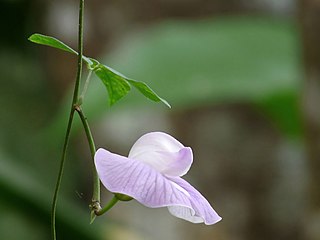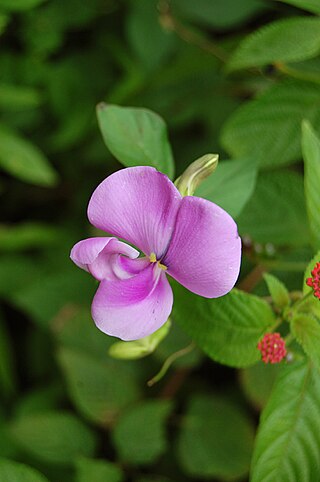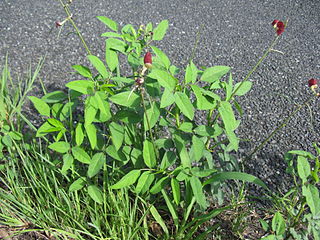
The mung bean, alternatively known as the green gram, maash ٫ mūng, monggo, or munggo (Philippines), is a plant species in the legume family. The mung bean is mainly cultivated in East, Southeast and South Asia. It is used as an ingredient in both savoury and sweet dishes.

The cowpea is an annual herbaceous legume from the genus Vigna. Its tolerance for sandy soil and low rainfall have made it an important crop in the semiarid regions across Africa and Asia. It requires very few inputs, as the plant's root nodules are able to fix atmospheric nitrogen, making it a valuable crop for resource-poor farmers and well-suited to intercropping with other crops. The whole plant is used as forage for animals, with its use as cattle feed likely responsible for its name.

Vigna subterranea is a member of the family Fabaceae. Its name is derived from the Bambara tribe, who currently lives in Mali. The plant originated in West Africa. As a food and source of income, the Bambara groundnut is considered to be the third most important leguminous crop in those African countries where it is grown, after peanut and cowpea. The crop is mainly cultivated, sold and processed by women, and is, thus, particularly valuable for female subsistence farmers.

Cytisus scoparius, the common broom or Scotch broom, is a deciduous leguminous shrub native to western and central Europe. In Britain and Ireland, the standard name is broom; this name is also used for other members of the Genisteae tribe, such as French broom or Spanish broom; and the term common broom is sometimes used for clarification. In other English-speaking countries, the most common name is "Scotch broom" ; however, it is known as English broom in Australia.

Enterolobium cyclocarpum, commonly known as guanacaste, caro caro, monkey-ear tree, or elephant-ear tree, is a species of flowering tree in the pea family, Fabaceae, that is native to tropical regions of the Americas, from central Mexico south to northern Brazil (Roraima) and Venezuela. It is known for its large proportions, expansive, often spherical crown, and curiously shaped seedpods. The abundance of this tree, especially in Guanacaste Province, Costa Rica, where it is prized for the shady relief it provides from the intense sun, coupled with its immensity, have made it a widely recognized species. It is the national tree of Costa Rica.

The winged bean, also known as cigarillas, goa bean, four-angled bean, four-cornered bean, manila bean, princess bean, asparagus pea, dragon bean, is a tropical herbaceous legume plant.

Vigna aconitifolia is a drought-resistant legume, commonly grown in arid and semi-arid regions of India. It is commonly called mat bean, moth bean, matki or dew bean. The pods, sprouts and protein-rich seeds of this crop are commonly consumed in India. Moth bean can be grown on many soil types, and can also act as a pasture legume.

Millettia pinnata is a species of tree in the pea family, Fabaceae, native to eastern and tropical Asia, Australia, and Pacific islands. It is often known by the synonym Pongamia pinnata. Its common names include Indian beech and Pongame oiltree.

Acaciella angustissima is most recognized for its drought tolerance and its ability to be used as a green manure and ground covering. It is a perennial, deciduous, and belongs to the family Fabaceae (beans/legumes) and as it grows it starts as a shrub but eventually matures to a small tree. The tree has a high density of leaves along with small clumps of white flowers and creates 4–7 cm long seed pods. Acaciella angustissima is found in tropical areas around the equator since, its water needs can vary from 750 to 2,500 mm a year. It has an advantage it can withstand a moderate drought, since its leaves are retained even in long dry periods. Aside from being drought tolerant, Acaciella angustissima also has the benefit of being a green manure, since it has such a high leaf density, but also loses the majority of its leaves each season. So the leaves can be used in composting or can be saved and used as livestock feed. It should only be used as an additive to the feed and not the main source, since it also toxic in high doses.

Inga edulis, known as ice-cream bean, ice-cream-bean, joaquiniquil, cuaniquil, guama or guaba, is a fruit native to South America. It is in the mimosoid tribe of the legume family Fabaceae. It is widely grown, especially by Indigenous Amazonians, for shade, food, timber, medicine, and production of the alcoholic beverage cachiri. It is popular in Peru, Ecuador, Pernambuco-Brazil, Venezuela and Colombia. The taxonomic name Inga is derived from its name with the Tupí people of South America, while the species name edulis is Latin for "edible". The common name "ice-cream bean" alludes to the sweet flavor and smooth texture of the pulp.

Vigna marina is a prostrate, creeping vine and a perennial plant. Also known as the beach pea, nanea, and notched cowpea, it is a species of legume in the family Fabaceae.

Centrosema pubescens, common name centro or butterfly pea, is a legume in the family Fabaceae, subfamily Faboideae, and tribe Phaseolae. It is native to Central and South America and cultivated in other tropical areas as a forage for livestock.

Calliandra calothyrsus is a small leguminous tree or large shrub in the family Fabaceae. It is native to the tropics of Central America where its typical habitat is wet tropical forests or seasonally dry forests with a dry season of four to seven months, when it may become deciduous. This tree grows to about 6 m (20 ft) and has pinnate compound leaves and flowers with a boss of prominent reddish-purple stamens. It is not very drought-tolerant and the above-ground parts are short-lived but the roots regularly resprout.

Neustanthus is a monotypic genus of flowering plants belonging to the pea family Fabaceae and its tribe Phaseoleae. The only species is Neustanthus phaseoloides, called tropical kudzu. This species is a forage crop and cover crop used in the tropics. It is known as puero in Australia and tropical kudzu in most tropical regions.

Vigna angularis, also known as the adzuki bean(Japanese: 小豆, azuki, Uncommon アヅキ, adzuki), azuki bean, aduki bean, red bean, or red mung bean, is an annual vine widely cultivated throughout East Asia for its small bean. The cultivars most familiar in East Asia have a uniform red color, but there are also white, black, gray, and variously mottled varieties.

Vigna luteola, commonly known as the hairy cowpea and the Nile bean, is a perennial vine found in many tropical areas.

Vigna trilobata, the African gram, three-lobe-leaf cowpea or jungle mat bean, is a regenerating annual herb found in India, Pakistan, Sri Lanka, Burma, Afghanistan and the Malay archipelago.

Vigna vexillata, the Zombi pea or wild cowpea, is a variable, perennial climbing plant that is pantropical, found in regions such as Ethiopia, Nigeria, and Venezuela.

Vigna parkeri, the creeping vigna or vigna menjalar, is a climbing or prostrate perennial vine that grows in subtropical areas such as Kenya, Indonesia, and Madagascar.

Macroptilium lathyroides is a species of plant in the legume family (Fabaceae) commonly known as the phasey bean. It is the type species of genus Macroptilium. Herbaceous annual or short-lived perennial growing up to 1 m high, it is native to the tropical and subtropical areas of Central and South America, and naturalized throughout the tropics. It is cultivated for forage or as a green manure or cover crop in rotation. As it quickly spreads on disturbed soils, it is considered an environmental weed in some areas.




















